Table of Contents
Keeping your customers happy is the secret sauce to staying ahead. Yet, to really understand what makes them tick, businesses turn to customer satisfaction metrics – handy tools that capture how customers feel and what you can do to make their experience even better.
Two of the most efficient tools businesses can use to measure customer happiness are the Customer Satisfaction Score (CSAT) and a newer Retently-born, but increasingly adopted metric called Customer Experience Score (XSAT). While they might seem similar on the surface, each one tells a slightly different story. Understanding these differences can shape how you track and improve customer satisfaction.
In this article, we’re going to break down the differences between CSAT and XSAT. Whether you’re looking for quick fixes or a broader view of long-term customer satisfaction, we’ve got you covered.
Key Takeaways
- Use CSAT to measure customer satisfaction with specific interactions or features, providing immediate insights that can drive quick improvements.
- XSAT is ideal for tracking customer satisfaction over time, helping businesses identify trends and make strategic decisions based on a broader understanding of customer experiences.
- Whether you need detailed, short-term feedback (CSAT) or comprehensive, long-term insights (XSAT), selecting the appropriate metric depends on your specific business needs and objectives.
- Combining customer satisfaction metrics can give you a well-rounded understanding of customer experience.
Understanding CSAT: The Traditional Metric
Customer Satisfaction Score is one of the simplest and most straightforward ways to measure how satisfied your customers are with a specific experience they’ve had with your brand. Whether it’s a recent purchase, a support interaction, or using a new feature, CSAT captures your customers’ immediate feelings about that specific touchpoint. Think of it as a quick pulse check on your customer’s happiness right after they interact with your business.
Formula Breakdown: The CSAT formula is straightforward: it’s the percentage of customers who say they’re satisfied with your product or service.
CSAT = Number of satisfied customers / Number of survey responses x 100
Here’s how it works:
- You ask customers a question like, “How satisfied were you with your experience?”
- Customers respond on a scale, usually from 1 to 5, where 1 is “very unsatisfied” and 5 is “very satisfied”.
- You calculate the percentage of customers who gave a score of 4 or 5 (the satisfied customers) out of the total number of responses. This looks at the percentage of customers who were satisfied with their most recent experience.
Example: Let’s say you sent a CSAT survey to 100 customers after a purchase. If 80 customers rated their experience as 4 or 5, your CSAT score would be:
CSAT = (80 satisfied customers / 100 total responses) × 100 = 80%
So, in this case, 80% of your customers are satisfied with their purchase.
Introducing XSAT: The New Metric
XSAT builds on the concept of CSAT, but with a twist – it goes a step further by tracking satisfaction over the long haul. Instead of focusing on just the most recent customer response, XSAT takes into account all the feedback a customer has given over time. This means it doesn’t just tell you how a customer feels right now – it gives you a running tally of their overall satisfaction with your brand. It’s a more comprehensive way to understand how your relationship with customers is evolving.
Formula Breakdown: The XSAT formula is similar to CSAT, but it’s applied to a larger dataset:
XSAT = Number of satisfied responses / Number of survey responses x 100
Example: Imagine you’ve been collecting satisfaction data from a customer over several interactions. Let’s say this customer has completed 10 surveys in total. If 7 of those responses were positive (a score of 4 or 5), your XSAT score would be:
XSAT = (7 satisfied responses / 10 total responses) × 100 = 70%
This score reflects the customer’s overall satisfaction across multiple touchpoints, not just their most recent experience.
CSAT vs XSAT: Key Differences
When it comes to understanding customer satisfaction, both CSAT and XSAT offer valuable insights, but they do so in different ways. Let’s break down the key differences between these two metrics to help you decide which one is right for your needs:
1. Granularity vs. Longevity
CSAT is all about granularity. It zeroes in on specific interactions – like a recent purchase, a customer support call, or the use of a new feature/service. This makes CSAT an excellent tool for getting detailed feedback on particular aspects of your business. For example, if you’re launching a new product feature, CSAT can tell you exactly how customers feel about it.
On the other hand, XSAT focuses on long-term consistency. Instead of capturing a single moment in time, XSAT aggregates all the feedback a customer has given over time. This gives you a broader, long-term perspective of their overall satisfaction with your brand.
2. Use-Case Specificity
Choosing between CSAT and XSAT often depends on your business goals and the specific questions you’re trying to answer.
When to Use CSAT?
Immediate Feedback: CSAT is all about the here and now. If you need quick, actionable insights about a specific interaction, CSAT is your go-to metric. It’s perfect for situations where you want to understand how satisfied customers are right after they’ve interacted with your business.
Specific Improvements: Use CSAT when you’re focusing on improving particular processes or features. For example, after making changes to your customer service process, you can use CSAT surveys to see if customers are happier with the new approach.
When to Use XSAT?
Long-term Satisfaction: If you want to track customer satisfaction over time, XSAT is the better choice. It’s great for businesses with ongoing customer relationships, like subscription services or industries with frequent touchpoints.
Broad Trends: Use XSAT when you want to identify long-term trends in customer satisfaction. For instance, XSAT can help you see whether satisfaction is steadily improving or declining.
3. Actionability: Immediate Action vs. Strategic Insights
When it comes to taking action based on customer feedback, CSAT and XSAT offer different types of insights, each valuable in its own way.
One of the biggest advantages of CSAT is how quickly you can act on the feedback it provides. Since it’s collected right after a specific interaction, you can address any issues immediately. For example, if a customer gives a low CSAT score after a support call, you can follow up right away to resolve their issue and improve their experience. This makes CSAT an excellent tool for day-to-day operational improvements.
While XSAT may not offer the same immediacy as CSAT, it provides deeper, more strategic insights. By looking at satisfaction over time, XSAT helps you identify patterns and trends that might not be visible from a single interaction. This is valuable for strategic planning, helping you make informed decisions about product development, customer experience and overall business strategy. As a matter of fact, Gartner research shows that 89% of businesses now compete mainly on customer experience, heavily influenced by long-term insights. For example, if XSAT reveals a gradual decline in satisfaction with a particular service, you can dig deeper and make strategic changes to address the core issues.
Integration with Other CX Metrics
While CSAT and XSAT are valuable on their own, they can be even more actionable when integrated with other customer feedback tools like NPS (Net Promoter Score) or CES (Customer Effort Score). Here’s how they can complement each other:
CSAT and NPS: Complementary Insights
CSAT focuses on specific interactions, while NPS measures the likelihood that customers will recommend your brand to others. By using both, you can get a detailed view of customer satisfaction at the interaction level (CSAT) and a broader sense of overall loyalty and brand perception (NPS). For example, if your CSAT scores are high but your NPS is low, it might mean that while customers are satisfied with specific interactions, they might not see your brand as exceptional or worth recommending.
XSAT and NPS: Strategic Overview
XSAT offers long-term insights into customer satisfaction, which can be paired with NPS to track how satisfaction over time influences customer loyalty. For instance, if your XSAT shows declining satisfaction over several months, it might explain a corresponding drop in NPS scores. Together, these metrics can guide your long-term customer retention strategies.
CSAT and CES: Operational Focus
CES measures how easy it is for customers to interact with your business, while CSAT measures their satisfaction with those interactions. Using both can help you identify not only how satisfied customers are, but also how easy it was for them to reach that satisfaction. For example, a high CSAT score paired with a low CES score might indicate that while customers are satisfied with the outcome, the process to get there was too complicated or frustrating.
XSAT and CES: Experience Improvement
Combining XSAT’s long-term satisfaction tracking with CES can help you understand how customer effort impacts satisfaction over time. If XSAT shows a decline, CES can provide clues as to whether increasing customer effort is a factor, allowing you to streamline processes and improve the overall customer experience.
Wrapping Up
There’s no one-size-fits-all approach to measuring customer satisfaction. Both CSAT and XSAT have their unique strengths, and the best way to understand your customers’ needs is to experiment with both. By trying out CSAT and XSAT in different scenarios, you’ll find out which metric – or combination of metrics – provides the most actionable insights for your business.
At Retently, we’re committed to streamlining feedback collection and analysis so you can focus on what truly matters: build deep, lasting loyalty. Leverage the free trial and start by designing a simple CSAT survey to capture immediate feedback, or set up an XSAT survey to monitor satisfaction over time. Test them out, analyze the results, and adjust your strategy as needed. Make sure to complement other tools like NPS and CES for a complete view.
Customer satisfaction is your business’s most valuable asset – use these metrics to keep it thriving. Let Retently support your customer experience efforts with precision and insight.



































 Christina Sol
Christina Sol 


 Greg Raileanu
Greg Raileanu 

